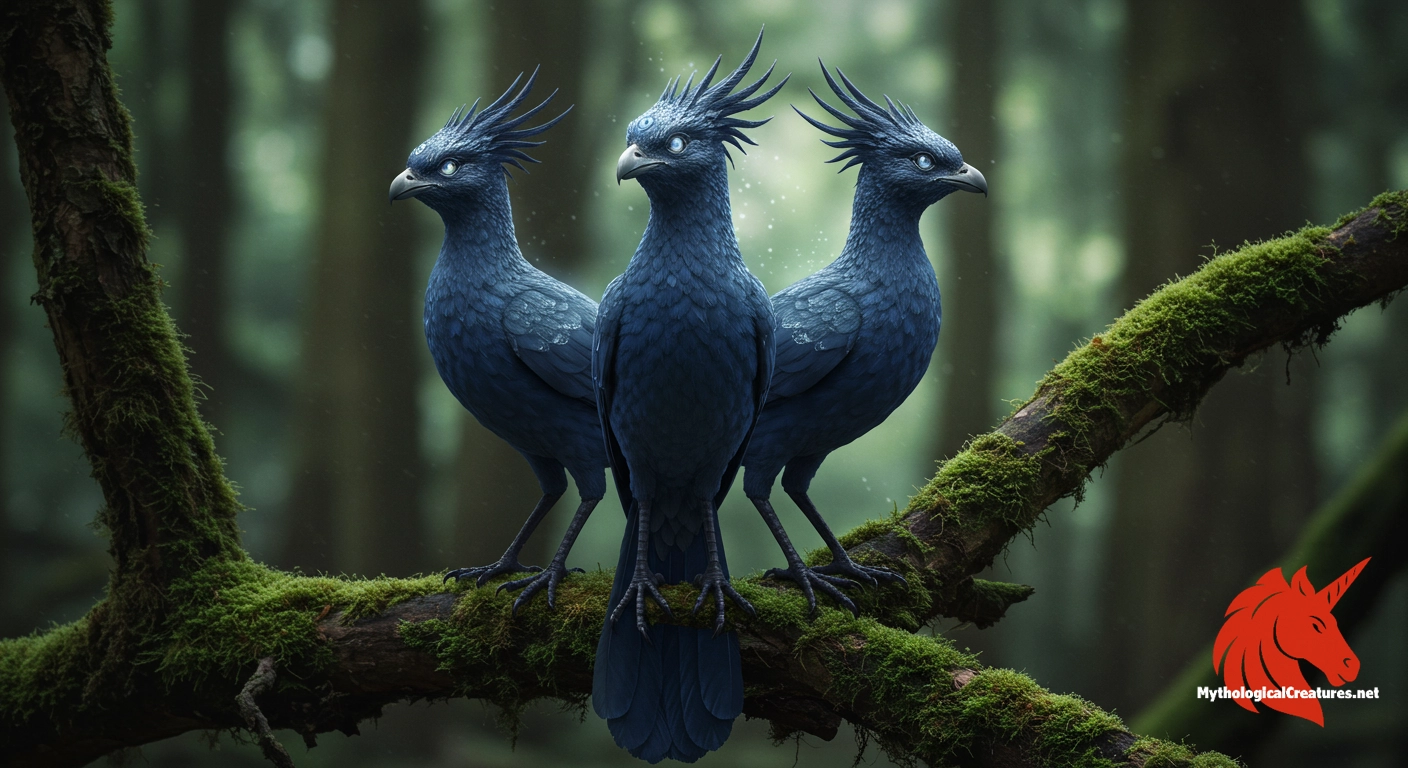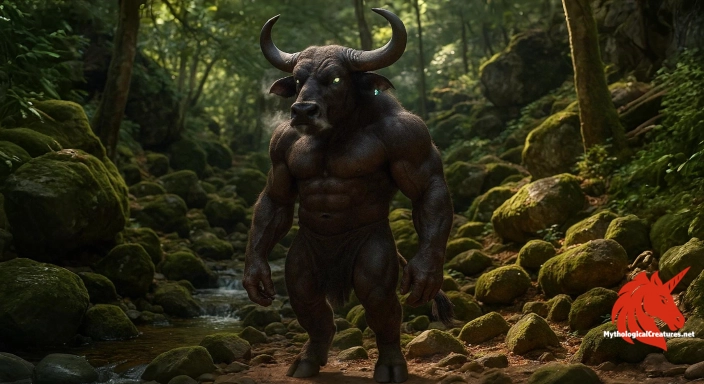Adar Rhiannon: Adar Rhiannon are three magical birds from Welsh mythology, featured in the Mabinogi.

Adar Rhiannon
Adar Rhiannon - They signify the intersection of the natural and supernatural realms and are emblematic of Rhiannon's influence in Welsh mythology.
Origins & First Encounters
Adar Rhiannon are a captivating ensemble of magical birds whose presence immediately evokes the mysterious aura of early Welsh myth. Their origin is traced back to the prose narratives of the Mabinogi, where they first appear entwined with the character of Rhiannon, a powerful figure often linked with a euhemerised form of a horse goddess. They bear an enigmatic quality, as their song is said to possess the paradoxical ability to wake the dead and lull the living to sleep. In these ancient tales, the birds are not merely creatures of the air but symbols of a deeper connection between the mortal and the divine realms. Their appearance in the myths of Britain reflects an era when natural phenomena and divine intervention were interwoven in storytelling. The trio of birds is carefully numbered, implying significant, perhaps even ritualistic, symbolism. Embedded in the narratives of marriage challenges and heroic quests, the Adar Rhiannon also mark a fascinating intersection between myth and societal customs of the time. Their legacy endures as a testament to the rich tapestry of Welsh cultural identity and narrative complexity.
Source Texts & Tale Variants
Early medieval manuscripts, most notably the Mabinogi, serve as the primary textual foundation for the story of the Adar Rhiannon. Tales in these texts position the birds at the heart of challenges imposed on heroic figures such as Culhwch during arduous quests. Variations of the narrative exist, with some sources emphasising the birds’ magical properties while others subtly suggest their connection with rites of passage and cosmic balance. In certain retellings, the birds are depicted as agents of both healing and ominous enchantment, capable of bridging life and death. The characters appear in contexts that mix narrative whimsy with solemn ritual, underscoring shifts in mythic storytelling across ages. Occasional later folklore and poetic fragments further reinterpret their role, lending the birds a dual function as both literal and allegorical beings. Some literary variants place a particular emphasis on the effect of their song on both space and time, highlighting the mystical and surreal aspects of their presence. Overall, the primary sources weave a tapestry where the Adar Rhiannon are central to narratives of divine intervention, courtship challenges, and the liminal spaces between different realms of existence.
Form & Powers
Although the ancient texts offer only delicate hints regarding their precise anatomy, the Adar Rhiannon have come to be envisioned as ethereal and strikingly beautiful birds. Imagined with a lustrous plumage that shimmers in hues that defy the ordinary, they evoke the essence of otherworldly splendour. Their feathers are often thought to bear a spectral glow, as if lit from within by some hidden, magical light. The details of their size and form might fluctuate in different accounts, yet most depictions suggest a modest stature coupled with an expansive and graceful wingspan. This contrast between delicate forms and commanding presence accentuates the birds’ paradoxical nature – both near yet mysteriously remote. Artists, inspired by the scant descriptions, have imbued them with features that blend natural elegance with supernatural allure. Their eyes are occasionally rendered with an intense, almost penetrating gaze that hints at ancient wisdom and secrets beyond mortal ken. These elusive physical details invite the mind to complete the picture, encouraging continual reimagining and deeper symbolism in their visual portrayal.
Regional Faces
The depiction of Adar Rhiannon retains a distinctly Welsh flavour, yet variations of their myth have been adapted across different Celtic regions and beyond. In Wales, they are deeply tied to Rhiannon herself, whose storied past as a queen and goddess permeates the myth. However, neighbouring cultural traditions have occasionally recast these enigmatic birds in roles that align with local spiritual and natural themes. In some Cornish and Breton narratives, for example, similar birds are portrayed as mystical intermediaries between human communities and the supernatural forces of nature. Variations in their symbolic importance emerge, with some regions accentuating their capacity to alter time and space, while others focus on their healing and life-affirming song. These regional adaptations reflect a broader tendency within folklore to mould mythic figures to fit local ideologies and ritual practices. Visual representations may differ subtly from one locale to the next, with distinctive artistic styles emphasising either the ethereal or the menacing qualities of the creatures. Collectively, these regional variants enrich the tapestry of the Adar Rhiannon myth, underscoring their flexible symbolism and enduring cultural resonance.
Cultural Parallels
In the world of myth and folklore, the Adar Rhiannon stand in fascinating parallel with other legendary avian figures from diverse traditions. Their magical song and transformative powers echo the allure found in legends of the phoenix and the mythical thunderbird, both of which similarly inhabit the liminal spaces between life and death. Much like the mystical Sirens of ancient Greece, whose voices enchanted sailors, these birds embody the dual edge of beguilement and danger through their compelling songs. Comparison can also be drawn with the Bennu of Egyptian lore, a bird associated with rebirth and the eternal cycle of life. Despite cultural differences, the recurring theme of birds possessing powers to both heal and disrupt underlines a common human fascination with the natural yet supernatural qualities of avian creatures. This cross-cultural analysis reveals that the number three – as exemplified by the trio of Adar Rhiannon – often signifies completeness and cosmic harmony in various mythic traditions. Their role as mediators of mystical forces connects them with thematic elements common to both Indo-European and Near Eastern mythologies. Such comparative insights illustrate how the motif of a potent, enigmatic bird resonates universally, bridging disparate cultures with a shared language of myth and metaphor.
Legacy & Modern Evolution
The evolution of the Adar Rhiannon myth over the centuries showcases a transition from a strict mythological role to a broader symbol of eternal mystery and transformation. In early literature, their presence was tightly interwoven with heroic quests and divine intervention, serving both functional and allegorical purposes in ritual narratives. As the medieval period waned, artistic reinterpretations began to cast them in roles that highlighted the symbolic interplay between life and death, reinforcing their status as liminal beings. In modern times, these birds have found a new life in the creative realms of fantasy literature, art installations, and even theatrical adaptations of the ancient tales. Contemporary culture often reimagines them through a lens that combines ecological consciousness with an appreciation for the mythic past, emphasising themes of rebirth and natural cyclicity. They now serve as an emblem of the interconnectedness of nature, spirituality, and the unknowable forces that shape our existence. Modern reinterpretations continue to draw on their mysterious musical abilities, often depicting their songs as metaphors for inner transformation and the transcendence of physical boundaries. Through ongoing scholarly and creative exploration, the legacy of the Adar Rhiannon remains a dynamic and inspiring touchstone for both historical study and modern myth-making.
Interesting Fact
It is fascinating that the birds not only defy typical spatial constraints but also serve dual roles as both life-bringers and as agents of sleep, reflecting the dual nature of magic in mythology.
Mythology-aligned partners
Showcase your myth-friendly brand here
Run a store, studio, or platform that lives in the world of myth and folklore? A curated sponsor panel on these pages may fit.
Explore partnership optionsQuick Creature Info
Features:
Our Mythic Legendary Rating:

Habitat:
Supernatural Powers:
Physical Attributes:
Abilities:
Behavior:
Lore:
References
Discover Another Mythical Legend You May Not Have Heard Of?
Uncover the mysteries of ancient folklore and expand your knowledge of legendary beings from cultures around the world.
Dare to Meet the Sarangay....
Curated by the Mythological Creatures Team
Series editor: Mythological Creatures Directory
Primary desk: Northern & European Folklore Desk
(rev. November 2025)
